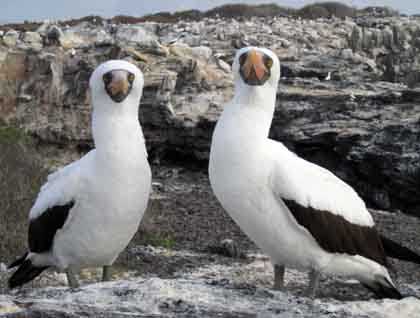Española is the southernmost island in the archipelago. At about five million years old it is also the oldest one, and has very few obviously volcanic features. Its flat terrain and low cliffs makes it an ideal nesting site for a great number of sea birds such as Nazca boobies, swallow-tailed gulls, and the largest sea birds in the Galapagos, the waved albatross.
After sailing south, early in the morning the National Geographic Endeavour dropped anchor in front of Gardner Bay on the east of Española Island. After breakfast we headed to Gardner islet to snorkel with playful juvenile sea lions, who made bubbles and followed us during our snorkeling, to the delight of our guests. We observed colorful fish, sting rays, and small invertebrates along the vertical walls of the islet.
After snorkeling we disembarked on the coralline sandy beach which was covered by a great number of sea lions, some of which swam animatedly with our younger guests. Along the beach we found the inquisitive Española mockingbirds, which walked close to us and inspected our bags and belongings to look for water or food. As I was in charge of the kayaks this morning, we left the beach and got to the area designated for kayaking. As soon our guests began to paddle along the cliffs, a soft rain refreshed the environment, which was a blessing for the thirsty mockingbirds that fluttered along the trees and sang out, as a signal of happiness, to find so much abundant water to drink.
In the afternoon, after a short navigation, the National Geographic Endeavor repositioned to Punta Suarez, a very different location with no beach, but an exuberant biodiversity of native and endemic species of animals. We observed several female marine iguanas with dusty bodies digging holes for laying their eggs. it is the lack of soft sand and beaches that are the reason these incredible creatures nest far from the ocean. We walked inland along boulders and dry trees to finally find one of the most incredible sea birds of the archipelago, the waved albatross. We observed many of them in various activities: mating, incubating eggs, taking off from the cliffs, and gliding in the air like kites. Their unmistakable noises and elaborate courtship dances were the delight of our guests who, while taking pictures or just observing, understood the magnificence of this natural paradise.
With the last beams of sun, tired but very happy, we enjoyed a beautiful sunset with some Nazca boobies and hawks flying overhead, decorating a unique landscape and helping us to remember this beautiful day in our minds forever.







